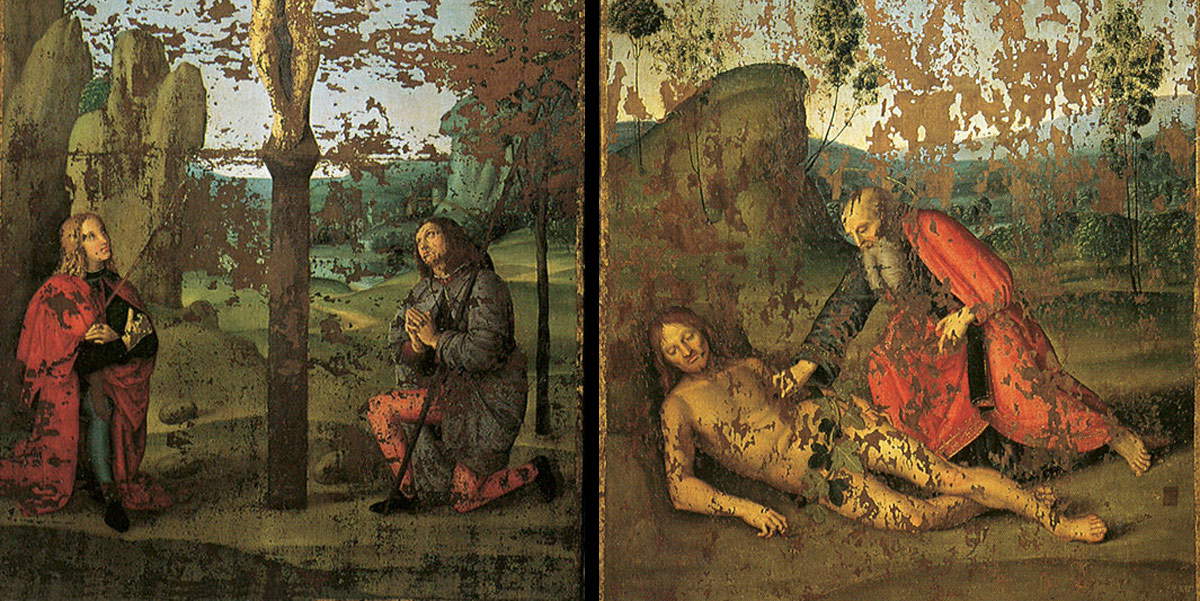The path of restoration of the Stendardo della Santissima Trinità by Raphael (Urbino, 1483 - Rome, 1520), housed in the Pinacoteca comunale of Città di Castello, enters a decisive phase with a visit to theIstituto Centrale per il Restauro in Rome, where the work is currently undergoing diagnostic and conservation work. The visit, carried out in the presence of Carmen Bambach, curator of the exhibition Raphael, sublime poetry, scheduled at the Metropolitan Museum of Art in New York from March 23 to June 28, 2026, was a pivotal moment in view of the loan of the painting, which will be presented to the U.S. public as the first fully autographed painting by the Urbino artist: endorsing this position is Bambach herself. Also present at the inspection were representatives of the City of Città di Castello, which holds custody of the painting, and the Soprintendenza Archeologia, Belle Arti e Paesaggio dell’Umbria, which oversees its authorization and scientific aspects.
During the visit, Carmen Bambach illustrated the importance of the Stendardo in the complex path of knowledge dedicated to Raphael’s early years, stressing how the ongoing research, supported and made possible by the restoration, is helping to reconsider the work’s role in the artist’s catalog. The scholar recalled how the Baronci Altarpiece, traditionally considered Raphael’s earliest work, is a work made in collaboration with another artist, Evangelista da Meleto, while the Stendardo presents autograph interventions on both sides, thus configuring itself as the first painting entirely by the master’s hand. Bambach pointed out that the diagnostic investigation is recovering part of the underlying drawing and clarifying aspects related to the technique and development of the composition.


“In the New York exhibition, the Stendardo della Santissima Trinità will be presented as the artist’s first fully autographed painting,” Bambach confirmed. “The Baronci Altarpiece, which is considered Raphael’s first work, is in collaboration with Evangelista da Meleto; the Stendardo, on the other hand, is on both sides by Raphael alone. Thanks to the restoration the sense of the painting will emerge more with the recovery of part of the underlying drawing and thus a vision of the artistic product, less focused on the archaeological level. Some gaps will be significantly reduced and there will be a new, more subtle balance between the paint film and the linen canvas support. In the exhibition project, for us to have this Stendardo means to innovate knowledge about young Raphael, presented as the artist’s first work, and it will be seen by the American public in relation also to Città di Castello, as a place where Raphael, a professional artist, emerges.”
The visit was also an opportunity for the City of Città di Castello to reiterate the importance of the work’s presence in the MET exhibition. Mayor Luca Secondi highlighted how the restoration is preparatory to an exhibition project that will allow the community of Città di Castello to show an international audience the city’s role in the formation of the young Raphael. “Here Raphael,” said the first citizen, “opened his first workshop and here he created his first work, according to the hypothesis being studied by art historians. Thank you to the MET for giving our community the opportunity to show the international public how the Renaissance reality of Città di Castello is a fundamental passage in Raphael’s artistic journey. We think the MET exhibition is an opportunity to see Raphael and our reality with different eyes.”
The Soprintendenza Archeologia, Belle Arti e Paesaggio dell’Umbria, represented by Alessandra Donati, reiterated its support for the project, clarifying that permission for the restoration and loan was granted because of the “scientific value of the project and the strong cultural and identity impact it will have,” she said. Donati explained that the restoration was created with the aim of improving the legibility of the work and increasing its knowledge, entrusting the Central Institute for Restoration with an intervention that combines scientific rigor, diagnostic analysis and special attention to the conservation history of the artifact.
The banner was probably painted around 1499, when Raphael was sixteen years old, for the Trinity Church in Città di Castello. That very year Raphael had arrived in Città di Castello as an independent artist, along with some of his father’s assistants, who had died five years earlier. It was a painting that immediately brought the artist great fame, given also the scarcity of talented artists in the Umbrian town.
The exhibition Raphael, sublime poetry, which will bring together works from international institutions and private collections, will provide a prominent space for the Stendardo, whose presence will allow a new interpretation of the early period of the artist’s career to be presented. The restoration underway at the ICR, thanks to its technical investigations and the philological reconstruction of the interventions, will make it possible to exhibit the work in a form that restores to the public the complexity of its material and iconographic history, placing it in a narrative context capable of putting the figure of the young Raphael in dialogue with the places that guard his legacy.
 |
| Raphael's first work is the Banner of Città di Castello: scholar's confirmation |
Warning: the translation into English of the original Italian article was created using automatic tools. We undertake to review all articles, but we do not guarantee the total absence of inaccuracies in the translation due to the program. You can find the original by clicking on the ITA button. If you find any mistake,please contact us.